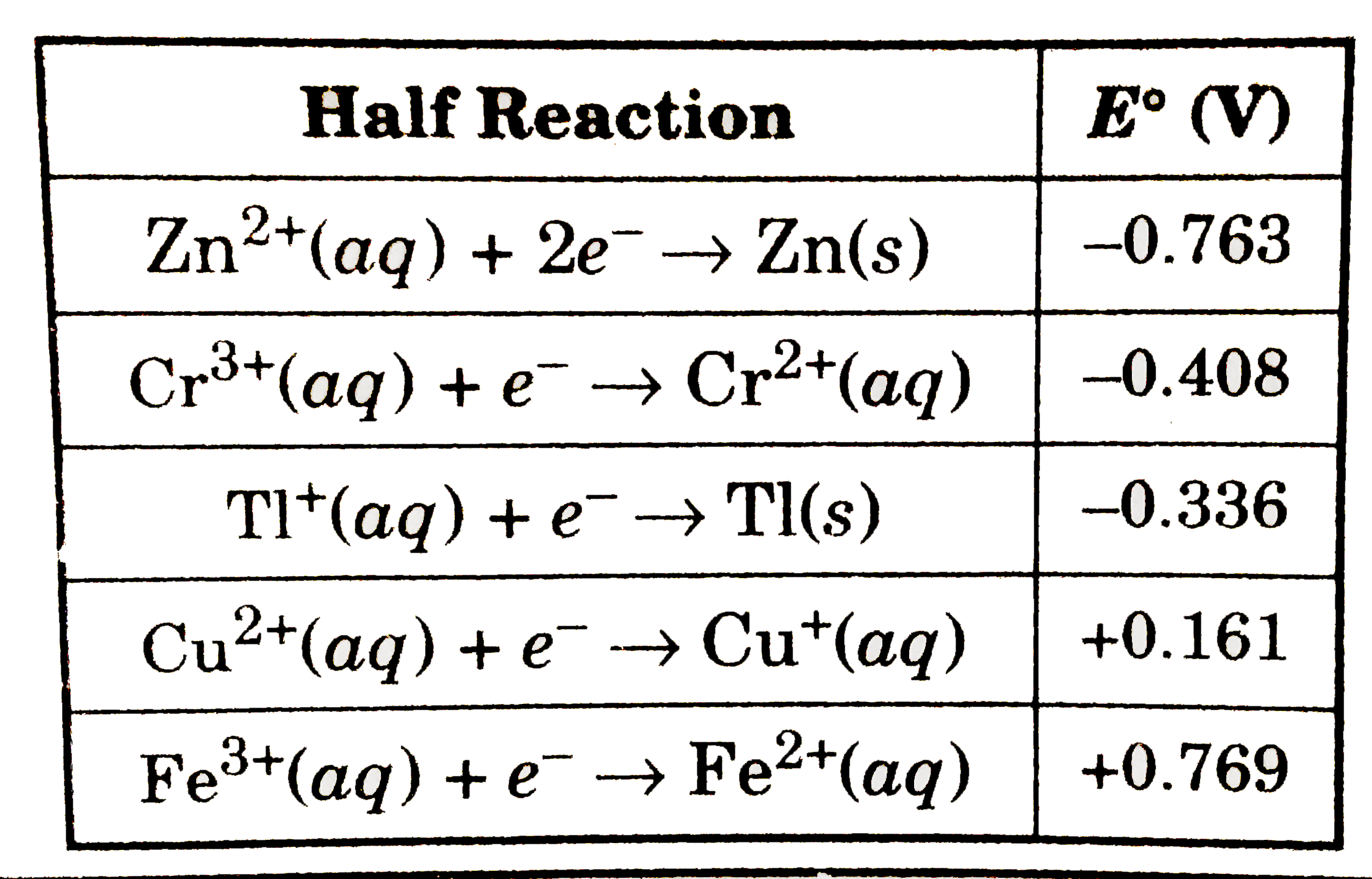Using the standard electron potentials given in the Table 8.1, predict if the reaction between the following is feasible :
(a) Fe3+(aq)andI−(aq)
(b) Ag+(aq)andCu(s)
(c) Fe3+(aq)andCu(s)
(d) Ag(s)andFe3+(aq)
(e) Br2(aq)andFe2+(aq) Solution in Telugu
Step by step video & image solution for Using the standard electron potentials given in the Table 8.1, predict if the reaction between the following is feasible : (a) Fe^(3+) (aq) and I^(-) (aq) (b) Ag^(+)(aq) and Cu(s) (c) Fe^(3+) (aq) and Cu (s) (d) Ag(s) and Fe^(3+)(aq) (e) Br_(2) (aq) and Fe^(2+) (aq) by Chemistry experts to help you in doubts & scoring excellent marks in Class 11 exams.
Updated on:21/07/2023Topper's Solved these Questions
- REDOX REACTIONS BOOK - NCERT TELUGUCHAPTER - REDOX REACTIONS EXERCISE - EXERCISES
30 Videos
- PURIFICATION OF ORGANIC COMPOUNDSBOOK - NCERT TELUGUCHAPTER - PURIFICATION OF ORGANIC COMPOUNDSEXERCISE - Questions
30 Videos
- THE P-BLOCK ELEMENTS BOOK - NCERT TELUGUCHAPTER - THE P-BLOCK ELEMENTS EXERCISE - Exercises
40 Videos
Similar Questions
Assign oxidation number to the underlined elements in each of the following species.
a) NaH2P––O4 b)NaHS––O4 c)H4P2–––O7
d) K2Mn––––O4 e)CaO2––– f)Naun∂∈e(B)H4
g)H2S2–––O7 h)KAlSO4–––––2.12H2O
View SolutionOrganic compounds are soluble in
View SolutionDiscuss the general characteristics of Group - 15 elements with reference to their electronic configuration, oxidation state, atomic size, ionization enthalpy and electronegativity.
View SolutionUsing the standard electrode potentials given in Table, predict if the reaction between the following is feasible : a. Fe^(3+)(aq) and I^(c-)(aq) b. Ag^(o+)(aq) and Cu(s) c. Fe^(3+)(aq) and Br^(c-)(aq) d. Ag(s) and Fe^(3+)(aq) e. Br_(2)(aq) and Fe^(2+)(aq) .
View Solution
Based on the standard reduction potentials above, which reaction(s) is (are) spontaneous?
(P) Cr2+(aq)+Fe3+(aq)→Cr2+(aq)+Fe2+(aq)
(Q) Cu2+(aq)+Fe2+(aq)→Cu2+(aq)+Fe3+(aq)
View SolutionUsing the standard electrode potentials given in the table predict if the reaction between the following feasible. (a) Fe^(3+)(aq) andI^(-)(aq) (b) Ag^(+)(aq) andCu(s) (c )Fe^3+ (aq) and Cu(s) Ag(s) and Fe^(3+) (aq) (Br_(2))(aq) and Fe^(2+)(aq) (d) Ag(s) and Fe^(3+)(aq) (e) Br_(2)(aq) and fe^(2+)(aq)
View Solutionसरणी 8.1 में दिए गए मानक विभवों की सहायता से अनुमान लगाइए कि क्या इन अभिकारकों के बीच अभिक्रिया संभव है ?
(क) Fe3+ तथा I−(aq)
(ख) Ag+ तथा Cu(s)
(ग) Fe3+(aq) तथा Br−(aq)
(घ) Ag(s) तथा Fe3+(aq)
(ड़) Br2(aq) तथा Fe2+
View SolutionUsing standard electrode potentials, predict the reaction, if any, that ocurs between Fe3+(aq)andI−(aq)
E∘Fe3+(aq)/Fe2+(aq)=0.77V,E∘I2/2I−(aq)=0.54V
View SolutionPredict if the reaction between the followig is feasible: (i) Fe^(3+)(aq) and I^(-)(aq) (ii) Ag^(+)(aq) and Cu (iii) Fe^(3+) and Br^(-1)(aq) (iv) Ag(s) and Fe^(3+)(aq) (v) Br_(2)(aq) and Fe^(2+)(aq) . Given standard electrode potential: E_(1//2I_(2),I^(-))^(@)=-0.541,E_(Cu^(2+),Cu)^(@)=0.34V E_(1//2Br_(2),Br^(-))^(@)=1.09V,E_(Ag^(+),Ag)^(@)=+0.80V,E_(Fe^(3+),Fe^(2+))^(@)=+0.77V
View Solutionसारणी 2.4 में दिए गए मानक विभवो की सहायता से अनुमान लगाइए कि क्या इन अभिकर्मकों के बीच अभिक्रिया संभव है
(क) Fe3+(aq) तथा I−(aq)
(ख) Ag+(aq) तथा cu(s)
(ग) Fe3+(aq) तथा Cu(s)
(घ) Ag(s) तथा fe3+(aq)
(ड़) Br2(aq) तथा Fe2+(aq)
View Solutionदिए गए मानक इलेक्ट्रोड विभव का प्रयोग कर बताइए कि निम्न अभिक्रियाएं सम्भव है या नहीं-
(i) Fe3+(aq) तथा I−(aq)
(ii) Ag+(aq) तथा Cu(s)
(iii) Fe3+(aq)तथा Br−(aq)
(iv) Ag(s) तथा Fe3+(aq)
(v) Br2(aq) तथा Fe2+(aq).
View SolutionUsing the standard electrode potentials given in the predict if the reaction between the following if feasible : (a) Fe^(3+) (a) and I^(-)(aq), (b)ag^(+)(aq)and Cu(s), (c )Fe^(3+)(aq)and Cu (s) (d) Ag(s)and Fe^(3+)(aq),(e )Br_(2)(aq)and Fe^(2+)(aq)
View SolutionUsing the standard electrode potentials given in Table, predict if the reaction between the following is feasible:
a.Fe3+(aq) and Ic−(aq)
b. Ag⊕(aq) and Cu(s)
c. Fe3+(aq) and Brc−(aq)
d. Ag(s) and Fe3+(aq)
e.Br2(aq) and Fe2+(aq).
View SolutionPredict if the reaction between the following is feasible :
Ag(s) and Fe3+(aq)
View Solutionनिम्नलिखित अभिक्रियाओं वाले गैल्वेनिक सेल का मानक सेल विभव परिकलित कीजिए।
2Cr(s)+3Cd+2(aq)→2Cr+3(aq)+3Cd(s)
Fe+2(aq)+Ag+(aq)→Fe+3(aq)+Ag(s)
E^0(Cd+2/Cd)= -0.4
E^0(Cr+3/Cr)= -0.74
E^0(Ag+/Ag)= 0.8
E^0(fe+3/fe+2)= 0.77
View Solution
